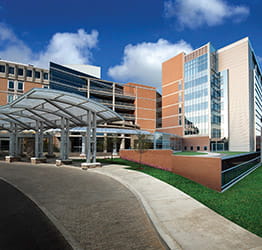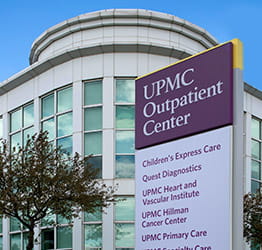On this page
What Is PKD?
Polycystic kidney disease (PKD) is a common genetic disorder that causes fluid-filled cysts to grow in your kidneys. Over time, these cysts can prevent your kidneys from working properly and may cause kidney failure.
What are the types of PKD?
There are two types of PKD, including:
- Autosomal dominant polycystic kidney disease (ADPKD) — Typically diagnosed in adulthood, ADPKD is the most common form of PKD. It happens when one biological parent passes a mutated (changed) PKD1 or PKD2 gene to their child.
- Autosomal recessive polycystic kidney disease (ARPKD) — Typically diagnosed during pregnancy or shortly after birth, ARPKD is a rare form of PKD. It happens when both biological parents pass a mutated (changed) PKHD1 gene or other gene to their child.

What causes PKD?
PKD happens when one or both biological parents pass a mutated gene to their child.
What are PKD risk factors and complications?
PKD risk factors
If you have a biological relative with PKD, you are at higher risk of developing PKD or carrying a mutated gene that you could pass to your child.
Complications of PKD
Over time, PKD can cause complications such as:
- Brain aneurysms.
- Colon problems, including diverticulitis.
- Cysts in other organs, including your pancreas or liver.
- Heart valve problems.
- High blood pressure.
- Kidney failure.
- Preeclampsia (high blood pressure during pregnancy).
How can I prevent PKD?
PKD is usually an inherited condition passed from parent to child. In some cases, PKD can develop through a gene that mutated on its own but was not inherited. There is nothing you can do to prevent PKD.
How common is PKD?
PKD is a common genetic kidney disorder affecting about 500,000 people in the U.S. ADPKD occurs in approximately 1 in 400 to 1,000 people worldwide, while ARPKD occurs in approximately 1 in 20,000 to 40,000 children worldwide. About 90% of people diagnosed with PKD have ADPKD.
Back to top.
What Are the Signs and Symptoms of PKD?
Symptoms of ADPKD in adults include:
ARPKD can sometimes be diagnosed before birth with a prenatal ultrasound. The ultrasound may show that the baby has larger-than-average kidneys, cysts on the kidneys, or low amniotic fluid levels.
Signs of ARPKD in children after birth include:
- Abdominal or low back pain.
- Difficulty breathing.
- Frequent UTIs.
- Growth problems (failure to thrive).
- High blood pressure.
- Low birth weight.
- Swollen abdomen.
What does PKD pain feel like?
If you have PKD, you may have sharp, stabbing pain in your back or the side of your abdomen that comes on suddenly, usually caused by a burst cyst, kidney stone, or urinary tract infection. You may also have chronic pain caused by enlarged kidneys or liver that feels like a nagging, dull ache that doesn’t go away.
When should I see a doctor about my PKD symptoms?
If you or your child has symptoms of PKD, you should schedule an appointment with your doctor right away — especially if a family member has also been diagnosed with PKD.
If you have already received a PKD diagnosis and have worsening symptoms, you should call your doctor.
Signs that your symptoms are getting worse may include:
- Breathlessness.
- Chest pain.
- Difficulty urinating.
- Swelling in your legs, ankles, or feet.
Back to top.
How Do You Diagnose PKD?
PKD is usually diagnosed with an imaging test such as a kidney ultrasound, prenatal ultrasound, CT scan, or MRI.
What to expect during your visit
During your visit, your doctor will:
- Ask about your family history of PKD.
- Order blood or imaging tests.
- Perform a physical exam.
- Review your health history.
Tests to diagnose PKD
Imaging tests for PKD
PKD is usually diagnosed with imaging tests, including:
- CT scan — A test that combines multiple x-rays to create detailed images of the organs, bones, and tissues in your body.
- MRI — Uses a combination of large magnets, radio frequencies, and a computer to produce detailed images of organs and structures within your body.
- Prenatal ultrasound — Uses sound waves to create images of your baby’s organs during pregnancy.
- Ultrasound (most common) — Uses sound waves to create images of your organs to check for problems.
Blood tests for PKD
In addition to imaging tests to diagnose PKD, your doctor may order blood tests to determine how well your kidneys work.
Blood tests include:
- Blood urea nitrogen (BUN) — Shows how well your kidneys are filtering urea nitrogen, a waste product, from your blood.
- Electrolyte and other tests — Checks for imbalances in electrolyte and mineral levels in your body, such as sodium, potassium, and bicarbonate.
- Estimated glomerular filtration rate (eGFR) — Shows how efficiently your kidneys function based on age, creatinine level, and sex.
- Genetic testing — Your doctor may recommend genetic testing to confirm a PKD diagnosis.
- Serum (blood) creatinine — Shows how well your kidneys are filtering creatinine, a waste product, from your blood.
Urine tests for PKD
Your doctor may also order urine tests, including:
- Urinalysis — Looks for abnormalities in your urine, such as a protein called albumin or blood in your urine that shows up when your kidneys aren’t working well.
- Urine output — Tracks how much urine your body produces each day.
PKD prognosis
There is no cure for PKD, and the outlook for people with PKD varies. With ongoing treatment and management, many people with PKD can live active lives. However, approximately 50% will experience kidney failure by age 60.
ADPKD prognosis
About 50% to 60% of people with ADPKD will have kidney failure by the time they are in their 60s or 70s, which will require treatment with dialysis or kidney transplant.
ARPKD prognosis
About a third of all babies born with ARPKD don’t survive their first month of life. Babies who survive their first month of life usually live into adulthood. About half of these children will develop kidney failure by age 15 to 20 and will need dialysis or kidney transplant.
Back to top.
How Do You Treat PKD?
There is no cure for PKD. However, researchers continue studying PKD to learn about the condition and find potential treatments.
The goals of PKD treatment are to:
- Manage symptoms.
- Reduce the risk of complications.
- Slow the progression of the disease.
Your PKD treatments may change over time as your condition progresses, but treatments will be lifelong.
Treatment options include:
Lifestyle changes
Improving your overall health may help to slow the progression of PKD or reduce your risk of complications.
Your doctor may recommend that you:
- Control chronic conditions — See a doctor for regular care if you have diabetes or high blood pressure.
- Drink water — Drink plenty of plain water and avoid caffeine.
- Eat healthy — Eat a healthy diet with lots of fruits and vegetables. They're high in potassium, which promotes healthy blood pressure. Limiting salt from shakers and processed foods also helps reduce your blood pressure.
- Exercise — Aim for at least 30 minutes of moderate-intensity physical activity most days of the week.
- Track your numbers — Routinely check your blood pressure and blood sugar (glucose).
- Keep track of medications — Inform your doctor if you routinely take over-the-counter drugs or herbal supplements and avoid or limit the use of NSAID medications (e.g., ibuprofen, naproxen).
- Manage stress — Take steps to manage stress and get at least 7-8 hours of sleep each night.
- Reduce alcohol intake — Limit alcohol to one drink a day for women and two drinks per day for men or less.
- Stop smoking — Quit smoking if you smoke cigarettes or marijuana.
- Treat kidney conditions — Get treatment right away if you develop kidney stones or a kidney, bladder, or urinary tract infection.
Medicine to treat PKD
A medication called tolvaptan can be used to slow the progression of ADPKD. Talk to your doctor to find out if this medication is right for you.
Your doctor may also recommend:
- Blood pressure drugs to reduce your risk of kidney failure.
- Diabetes drugs to lower your blood sugar.
- Diuretics to regulate fluid levels in your body.
- Pain medications to manage discomfort.
Dialysis for PKD
If your PKD progresses to end-stage kidney disease or kidney failure — which is defined as having less than 15% of your normal kidney function — it can cause toxic waste to build up in your body. You may need to have dialysis, also called renal replacement therapy, to filter and clean your blood.
What happens during dialysis?
During dialysis, a machine cleans waste from your blood and helps control your blood pressure.
There are two common types of dialysis:
- Hemodialysis — Performed using a machine at a dialysis clinic or home three times a week for about four hours.
- Peritoneal dialysis — Performed through a catheter in your abdomen at home.
How effective is dialysis for PKD?
If you have end-stage kidney disease, dialysis is a lifesaving treatment option. Without it, toxins and fluid would build up in your body and cause death within days or weeks.
However, for most people, dialysis is only a short-term treatment. In time, you may need a kidney transplant.
Supportive care without dialysis
Although dialysis treatments are lifesaving for many people, they can be hard and sometimes painful for others.
For people with advanced kidney disease who want to avoid dialysis treatment, renal supportive care can offer hope and comfort.
Supportive care aims to:
- Treat the symptoms of kidney disease.
- Enhance your quality of life.
Kidney transplant to treat PKD
If you have PKD that has caused kidney failure, a kidney transplant may be the key to getting you back to your healthy life.
You should talk to your doctor about whether a kidney transplant is an option for you. We partner with UPMC kidney transplant experts to provide care before, during, and after the transplant.
Why choose UPMC for PKD care?
When you choose UPMC for PKD care, you will receive:
- Access to world-class nephrology expertise — Our world-renowned experts treat the full spectrum of kidney diseases using the latest diagnostic and treatment techniques.
- A full range of treatment options — We'll work with you to develop a treatment plan that slows the progression of your disease as much as possible and improves your quality of life.
- Multidisciplinary care — We partner with special dialysis clinics, experts in supportive care, and kidney transplant surgeons to ensure you receive complete care.
Back to top.
By UPMC Editorial Staff. Last reviewed on 2025-04-24 by William Hoffman, MD.
















